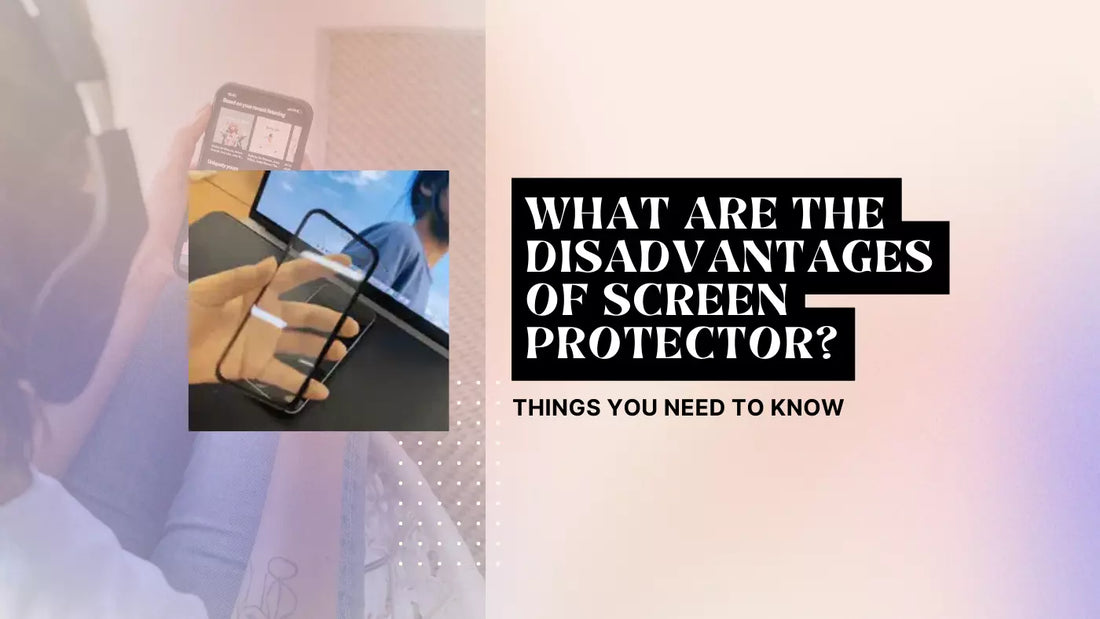
What Are the Disadvantages of Screen Protector? Things You Need to Know
Share
One of the most common complaints about screen protectors is that they can decrease touch responsiveness on your smartphone.
This is particularly true for tempered glass screen protectors, often thicker than their plastic counterparts. Reduced touch sensitivity can make typing, scrolling, and performing other touch gestures on your phone more difficult.
For example, you might press harder on the screen or swipe multiple times before your device registers the action.
To minimize this issue, consider using thinner plastic screen protectors. While they may not offer the same level of protection as tempered glass, they typically have less impact on touch sensitivity.
Impaired Display Quality
Some screen protectors, especially anti-glare and privacy screen options, can reduce the clarity and brightness of your smartphone display. These protectors often have a matte finish or incorporate additional layers to achieve their desired effect.
For instance, anti-glare screen protectors work by diffusing light reflections, which can lead to a dimmer, less vibrant display.
Similarly, privacy screen protectors may make viewing your screen difficult for people around you. Still, they can also darken the display and distort colors.
To avoid these issues, look for high-quality glass screen protectors to maintain your device's display quality.
Trapped Dust and Bubbles
No matter how carefully you apply a screen protector, there's always a chance that dust particles or air bubbles will become trapped underneath.
These imperfections can compromise both the appearance and functionality of your screen. For example, dust and bubbles can create small dead zones where your touch gestures won't register, or they can be an eyesore.
To minimize trapped dust and bubbles, clean your screen thoroughly before applying a protector, and follow the installation instructions closely.
Peeling and Discoloration
Over time, screen protectors can peel, crack, or become discolored, which can be both unsightly and reduce their effectiveness. Plastic screen protectors are particularly susceptible to these issues, as they're more prone to damage from UV light and general wear and tear.
To extend the life of your screen protector, choose a high-quality, durable option, and clean your phone regularly to prevent dirt and grime from accumulating at the edges.
Additional Costs and Efforts
Purchasing and replacing screen protectors can add up, especially if you opt for more expensive tempered glass options. Additionally, the time and effort required for proper installation and maintenance can be a hassle.
Before deciding to use a screen protector, weigh the pros and cons, and consider investing in a durable device case instead. Cases can protect your phone from scratches, drops, and other damage, without the disadvantages associated with screen protectors.
Environmental Impact
Screen protectors, especially disposable plastic ones, can contribute to waste generation and environmental pollution. When you're done using them, they often end up in landfills or incinerators, where they can release harmful chemicals.
Alternatively, consider more eco-friendly and sustainable options, such as biodegradable screen protectors or a durable phone case.

Frequently Asked Questions
1. Do I need a screen protector for my smartphone?
Whether you need a screen protector depends on your personal preferences and how you use your device. Some people prefer the added protection and peace of mind, while others find the disadvantages outweigh the benefits.
Before deciding, consider potential drawbacks, such as reduced touch sensitivity and display quality. Also, keep in mind that a high-quality phone case can provide adequate protection for many users.
2. What's the difference between tempered glass and plastic screen protectors?
Tempered glass screen protectors are made from chemically strengthened glass that is more durable and resistant to scratches than plastic protectors. They usually offer better protection but can be thicker and more expensive.
Plastic screen protectors, on the other hand, are thinner and more flexible. Still, they may provide a different level of protection than tempered glass. They can be more prone to peeling and discoloration.
3. How do I properly install a screen protector?
To install a screen protector correctly, follow these steps:
- Clean your screen thoroughly with a microfiber cloth and an alcohol-based cleaner to remove dust, fingerprints, and smudges.
- Peel off the protective layer from the adhesive side of the screen protector.
- Carefully align the protector with your device's screen, making sure it matches the cutouts for the camera, speakers, and buttons.
- Press the protector onto the screen, starting from the center and moving outward to eliminate air bubbles.
- Use a squeegee or credit card to smooth out any remaining bubbles.
4. How often should I replace my screen protector?
The frequency at which you should replace your screen protector depends on the quality of the protector and how you use your device.
Generally, if your screen protector is peeling, cracking, or becoming discolored, it's time to replace it. Some users may need to replace their protectors every few months, while others may only need to do so every few years.
5. Can screen protectors help reduce blue light exposure?
Yes, some screen protectors are specifically designed to filter out blue light, which is believed to contribute to digital eye strain and disrupt sleep patterns.
If you're concerned about blue light exposure, look for a screen protector with blue light filtering capabilities. However, remember that these protectors may slightly alter the colors displayed on your screen.
Conclusion
While screen protectors can help protect your device from scratches and damage, they have disadvantages. From reduced touch sensitivity to impaired display quality and environmental concerns, it's essential to consider the pros and cons before deciding to use one.
Ultimately, it's about finding the right balance between protection and functionality for your needs.
I highly recommend checking out my other article master your iPhone - top 17 questions answered

